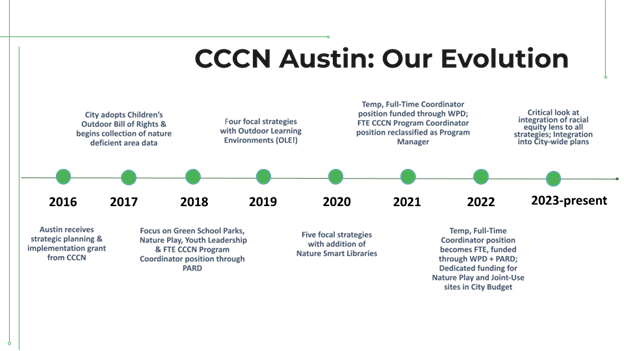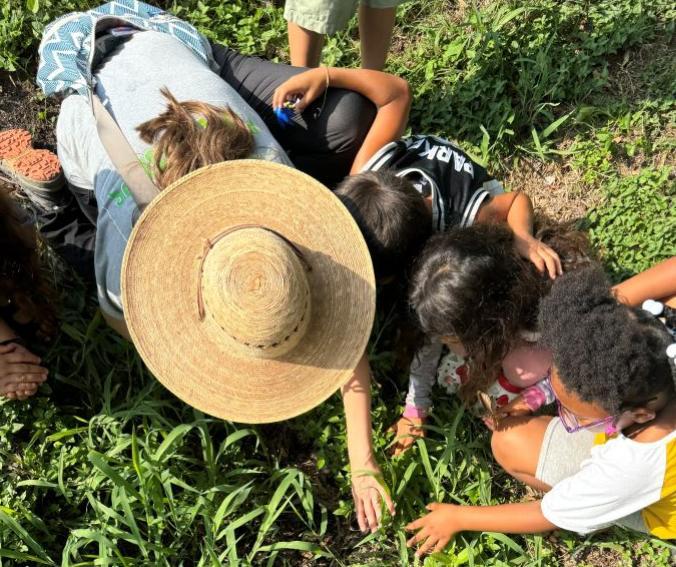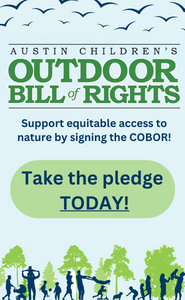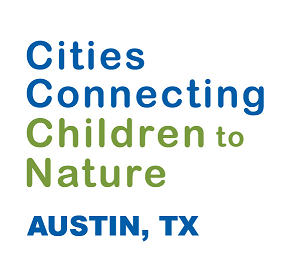Austin Initiative
Vision
Cities Connecting Children to Nature Austin strives to ensure every child has access to and connection with nature every day.
Mission
We are committed to connecting people with the natural spaces where they live, learn, and play, which fosters lifelong beneficial relationships with nature. CCCN collaborates across institutions and systems, amplifying efforts, sharing resources, and creating partnerships that deepen our collective vision and advance our mission.
Guiding Framework
The creation of the Children's Outdoor Bill of Rights (COBOR) illustrates what equitable access to nature should look like in Austin and establishes a common foundation and high aspirations for nature connection in the community. Austin City Council unanimously voted to pass the COBOR on January 26, 2017. Show your support for Austin’s Children’s Outdoor Bill of Rights by signing the pledge form.

The 2016 Nature Equity Map was developed in to identify areas of Austin that are nature deficient and help guide CCCN efforts. Areas of highest impact were determined through an analysis of multiple factors including median household income, inverse tree canopy, child population, waterways coverage, justice 40, parkland coverage. Due to the rapid growth of Austin, we updated the 2016 Nature Equity Map to reflect new data to include additional impacts to nature equity such as transportation to parkland, facilities, public and private schools, and more. The 2022 Nature Equity Map continues to inform us our selection of the areas where priority implementation strategies will be focused.

Strategies
CCCN Austin strives to increase equitable access to nature for all children by creating connections where children live, learn and play. We bring together community partners, neighbors, and city leaders to drive change in areas that have historically faced underinvestment in green spaces. Through five interconnected strategies, our work advances multiple citywide initiatives transforming systems for lasting change.
- Early Childhood
-
Improve outdoor spaces at childcare centers to enable 0–5-year-olds to be active, learn in nature and develop conservation habits.
- 0-5 years old
- Integrate nature through design.
- Increase staff comfort and familiarity to bring play and learning outdoors.
- Develop a network for childcare centers to share knowledge and community.

- Green School Parks
-
Every schoolyard creates access to nature and fosters play and learning outdoors for all.
- 5-18 years old
- Incorporate natural infrastructure into schoolyard design.
- Integrate nature into learning.
- Ensure community access to schoolyards outside of school hours.
- Green School Park self-designation form.

- Emerging Green Leaders (EGL)
-
Elevate youth voices and create a pipeline for youth, particularly those from historically underrepresented communities, to nature-based professions through training, networking and mentorship.
- 14-24 years old
- Youth leadership development in green careers.
- Collaborate with partners on equitable recruitment and hiring.
- Relationship building between peers, partners, and nature.

- Nature Play
-
Building a world where all children can explore nature through play.
- all ages, families, community
- Integrate nature play through infrastructure and programming.
- Develop and implement City policies to increase nature access and connection.
- Citywide collaboration to reuse natural materials in park development.
- Loose Parts Lending Kits
- Nature Play Guidelines

- Nature Smart Libraries
-
Foster connections to nature through stories, experiences, and resources to promote curiosity and environmental literacy.
- Community
- Incorporate nature into library design and development.
- Bring literacy opportunities into natural spaces.
- Provide programs that include nature and the environment.











